Batteries in series vs parallel: what are the differences?
Batteries in series vs parallel: what are the differences?
Solar energy is becoming an increasingly popular source of renewable energy. It is clean, sustainable, and provides an excellent alternative to traditional fossil fuels. However, the issue with solar energy is that it is intermittent and not always available. You may check out more in another blog - Solar Energy Myths and Fact.
Therefore, to ensure continuous supply, solar energy is stored in batteries. In a solar power system, the batteries are an essential component that stores the energy generated during daylight hours for use at night or when there is no sunlight.
In this article, we will delve into the world of battery connections, exploring the series connection, parallel connection, and series-parallel connection along with the benefits and drawbacks of each connections type, and how to choose the right configuration for your needs.
Table of contents:
- Batteries in series vs Batteries in parallel
- Batteries in Series: Advantage and Disadvantages
- Batteries in Parallel: Advantage and Disadvantages
- How to connect batteries in Series
- How to connect batteries in Parallel
- How many batteries can you wire in series?
- How many batteries can you wire in Parallel?
- Is it possible to wire batteries in series and parallel at the same time?
- How to create a series-parallel connection?
- Do Batteries last longer in series or parallel?
- Does series or parallel give more power?
- When would you use batteries in parallel?
- What happens when you connect two 12 volts batteries in series?
- What happens if batteries are not properly connected?
- Can you wire different batteries in parallel?
- What happens when connecting two batteries of different amp hour rating in parallel?
- Buy the safest lithium batteries for your RV
Batteries in series vs Batteries in parallel
Batteries are connected in different combinations depending on the specific requirements of the circuit or device they are being used in. They can be arranged in either a series or a parallel configuration or in a series-parallel combination. The way in which batteries are connected affects the voltage and current in the circuit.
Batteries in Series
Batteries in series combination are connected end-to-end, so that the positive terminal of one battery is connected to the negative terminal of the next battery. The voltage of the batteries is added together, so if two 12-volts batteries are connected in series, the total voltage would be 24 volts. However, the current remains the same as that of a single battery.
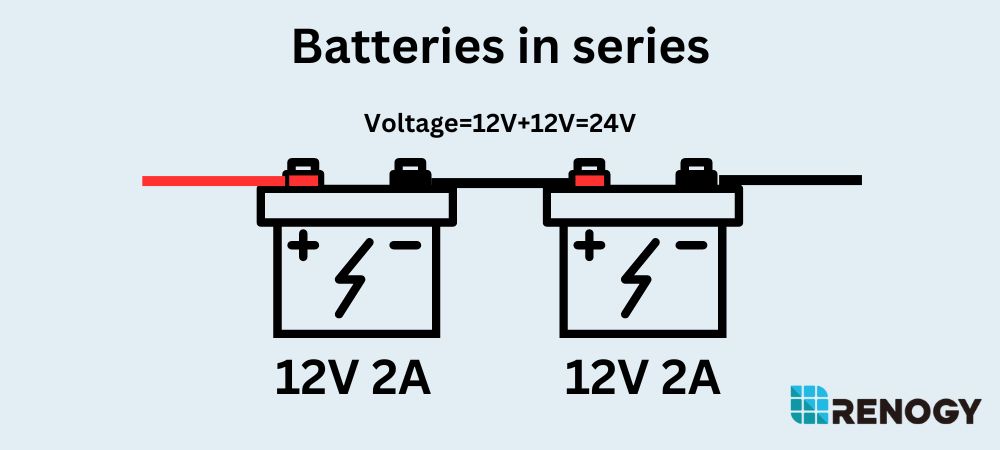
In solar energy systems, the connection is done until all the batteries in the system are connected. The remaining positive and negative terminals of the battery string are then used as the positive and negative output terminals.
Batteries in Parallel
Batteries in parallel combination are connected so that all the positive terminals of the batteries are connected together, and so on all the negative terminals are connected together. The total voltage of the batteries remains the same, however the current is added together. So, if two batteries with a current capacity of 2 amp are connected in parallel, the total current capacity would be 4 amps.
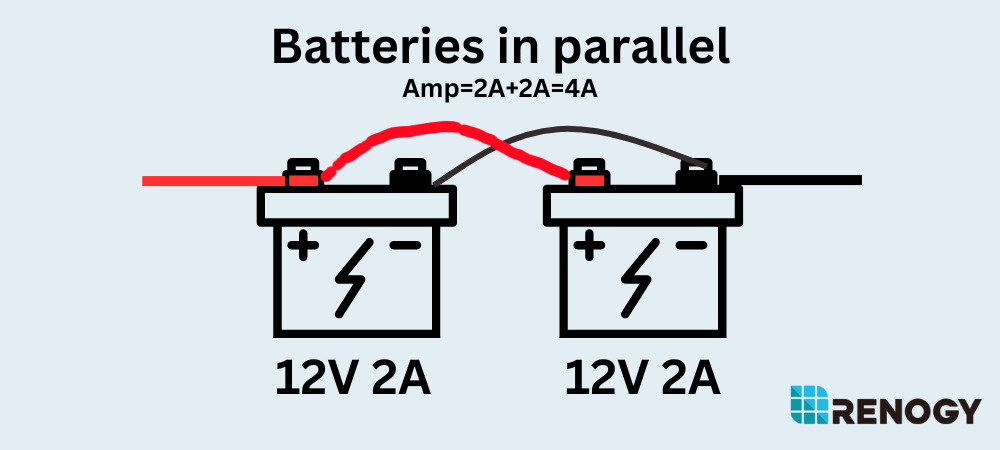
In solar energy systems connecting batteries in parallel involves connecting the positive terminals of all batteries together and the negative terminals of all batteries together. The positive and negative output terminals are then taken from the remaining terminals of the battery bank.
Batteries in Series: Advantage and Disadvantages
Though connecting batteries in series can boost the voltage output, there are also some weaknesses.
Advantages:
Connecting batteries in series increases the overall voltages of the circuit which is useful in a case when we need to power a device that require higher voltage.
By distributing the load across the batteries and reducing the stress on individual batteries, connecting batteries in series can improve the system's overall efficiency.
The systems ability to store energy is increased when batteries are connected in series. This can be useful in a condition when you need to power devices for extended periods such as in remote areas with few power sources. Batteries in series are installed easily and it does not require complicated wiring or installation procedures, therefore the cost on wires are less than parallel connections.
Disadvantages:
If one battery in the series is weaker than the others it can become overcharged or undercharged which can reduce its lifespan and negatively impact the overall system performance.
An external device is usually required for balancing the charge and discharge such as the battery equalizer. Connecting batteries in series can reduce their lifespan. As the batteries may not discharge evenly which can cause some batteries to discharge more quickly than others leading to premature failure of the batteries.
If one battery in the series connected batteries fails, it can cause the entire system to fail. This can be problematic in situations where reliable power is critical.
Connecting batteries in series requires additional wiring and components which can increase the complexity of the system. Thus, making installation and maintenance more difficult.
Batteries in Parallel: Advantage and Disadvantages
Advantages:
Connecting batteries in parallel increases the overall power output of the system which can be useful when powering devices with high power demands.
If one battery in the parallel connection fails, the others can continue to operate. Thus, reducing the risk of system failure.
When batteries are connected in parallel, they all receive the same voltage. Thus reduces the risk of one battery becoming overcharged or undercharged.
Disadvantages:
Connecting batteries in parallel does not increase the energy storage capacity of the system as much as connecting them in series does.
When batteries are connected in parallel, the overall system efficiency can be reduced due to differences in the voltage and current output of the individual batteries.
Connecting batteries in parallel can be more expensive as it requires additional wiring and components. If one battery in the parallel connection overheats, it can cause the others to heat up as well, leading to a potential thermal runaway situation that can damage the batteries and the system.
How to connect batteries in Series
Connecting batteries in series involves connecting the positive terminal of one battery to the negative terminal of another battery.
Here are the few steps to connect batteries in series:
1.Make sure that the batteries are the same voltage and type as the series connection of batteries with different voltages or chemistries might result in damage to the batteries or the equipment.
2.Batteries can be heavy, so make sure they are in a secure location where they will not move or tip over.
3.The positive terminal is typically marked with a "+" sign, and the negative terminal is marked with a "-" sign. So, identify the positive and negative terminals.
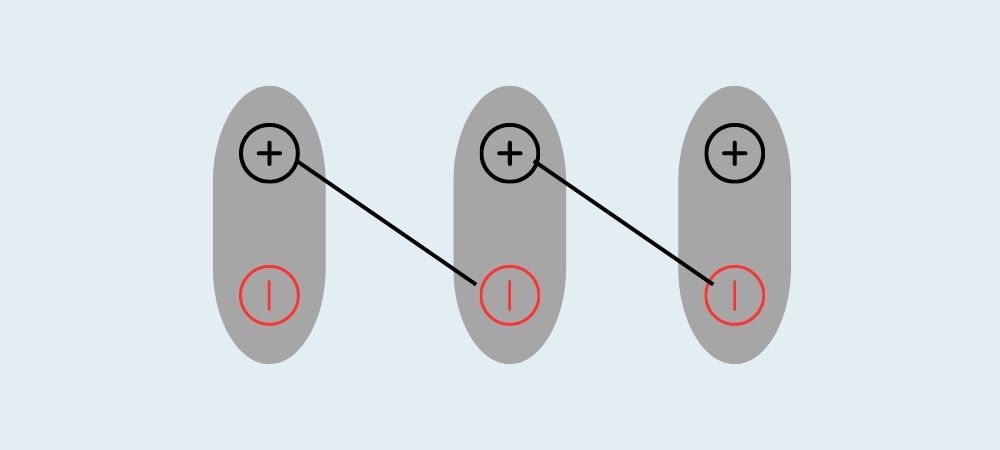
4.Connect the positive terminal of the first battery to the negative terminal of the second battery using a jumper cable or wire to connect the two terminals. Make sure the connection is secure.
5.Repeat the process for the remaining batteries by connecting the positive terminal of the second battery to the negative terminal of the third battery, and so on, until all the batteries are connected in series. 6.Verify the connections by double-checking all the connections to make sure they are secure, and the polarities are correct. 7.The batteries are now connected in series and can be used to power equipment that requires the higher voltage output.
How to connect batteries in Parallel
The installation steps for connecting batteries in parallel are same as series connection and they differ in the steps mentioned below;
1.Connect the positive terminal of one battery to the positive terminal of the other battery using a battery cable.
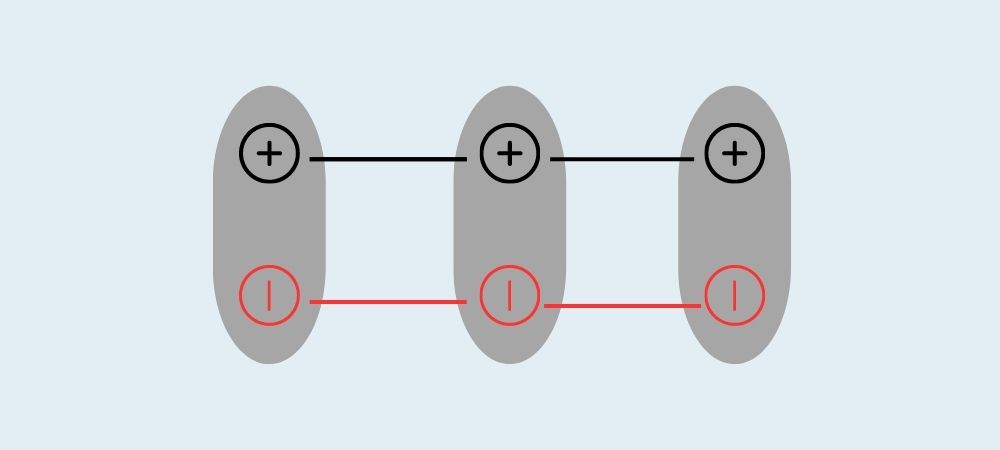
2.Connect the negative terminal of one battery to the negative terminal of the other battery using another battery cable.
3.Repeat the process with all the batteries you want to connect in parallel. 4.Finally, connect the positive and negative terminals of the parallel-connected batteries to the solar charge controller or inverter.
Note: It's recommended to consult a qualified electrician or solar installer before attempting to connect solar batteries in series or parallel to ensure proper installation and safety precautions are taken.
How many batteries can you wire in series?
The number of batteries that can be wired in series depends on the voltage of each battery and the voltage requirements of the device or system that they are discharging.
However, there is a limit to the number of batteries that can be connected in series. Exceeding this limit can cause the voltage to become too high and potentially damage the device or system.
For lithium batteries of 12 Volt, the number of batteries connected in series should be limited within four. One thing to keep in mind is that lithium batteries with BMS are not allowed for series connection, such as Renogy’ lithium ion phosphate batteries.
In contrast, you can wire any number of lead acid batteries in series as long as their total voltage is within the limits of the charge controller or inverter being used. It's also important to ensure that the charge controller or inverter being used is compatible with the voltage of the battery bank.
How many batteries can you wire in Parallel?
The number of solar batteries that can be connected in parallel depends on several factors including the type of batteries, their capacity, and the application requirements. Generally, you can wire up to eight solar batteries in parallel, no matter they are lithium batteries or lead acid batteries.
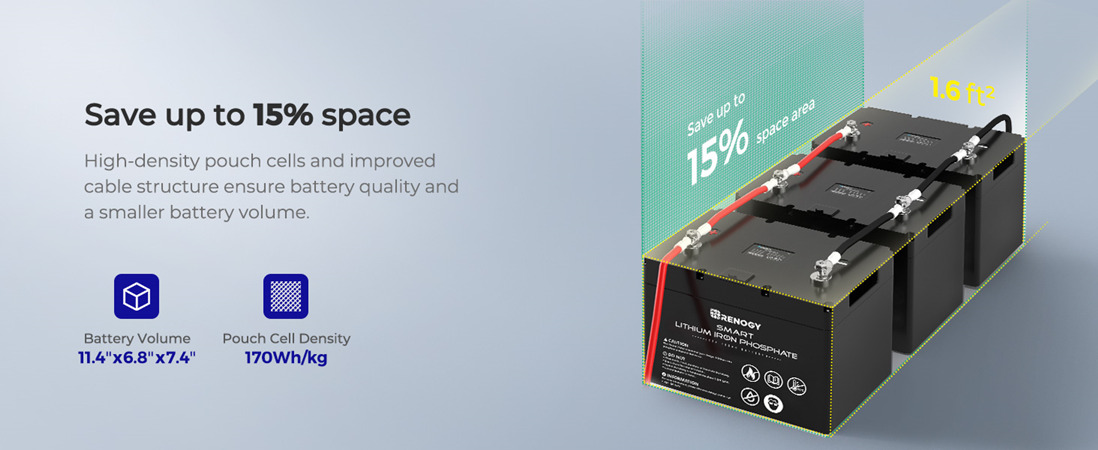
It is important to note that wiring too many numbers of batteries in parallel can leads to a number of problems, such as unequal charging and discharging rates, higher risk of overloading, and shorter overall lifespan of the battery bank. Therefore, it is advised to consult with a qualified engineer or electrician to design the optimal battery system for your specific application.
A larger battery bank will typically require more maintenance and have a higher upfront cost, but it can provide longer backup power and better efficiency in the long run. Thus, it is important to consider the overall capacity of the battery bank and ensure that it is sufficient for your needs.
Is it possible to wire batteries in series and parallel at the same time?
Yes, it is possible to wire batteries in both series and parallel at the same time. Series-parallel battery configuration is a way to connect batteries both in series and parallel. Such type combinations are used to increase both the voltage and capacity of the battery system according to the specific requirements.

How to create a series-parallel connection?
A series-parallel connection of batteries is a way wiring batteries in both series and parallel to create a larger battery bank with increased capacity and voltage. Such type of combination of batteries are made to achieve a specific voltage and capacity requirement for a given application.
To create a series-parallel connection, In pairs, batteries are first wired in parallel to increase the overall capacity of the battery bank. The positive terminals of each battery are wired together and similarly the negative terminals are connected together. The number of batteries for parallel connections depends on the capacity requirement of the application. Each pair of batteries in parallel will be regarded as a group.
Then parallel each group of the batteries to achieve the specific voltage. This is done by connecting the positive terminal of the first parallel string to the negative terminal of the second parallel string, and so on, until the required voltage is achieved. The final positive and negative terminals are used to connect the battery bank to the load.
For example, if you have four 12 Volts batteries with a capacity of 100 Ampere hours each. To create a 48 volts battery bank with increased capacity, wire the four batteries in parallel to create a bank with a total capacity of 400 Ampere hours. Then wire two of these parallel string in series to achieve a final voltage of 48 Volts .
It is important to ensure that all batteries used in a series-parallel configuration are of the same type, have the same capacity and voltage, and are properly balanced to prevent overcharging or discharging of individual batteries.
Notice: it is usually series connecting batteries as the first step and takes parallel wiring the second place. Either way can work. But making series connections prior to parallel boasts higher safety.
Do Batteries last longer in series or parallel?
The lifespan of batteries in either configuration depends on several factors, including the quality of the batteries, the type of chemistry used, the depth of discharge, and the charging and discharging rates. Therefore, it's important to choose the appropriate configuration for your specific application and to follow proper battery maintenance procedures to ensure the longest possible lifespan.
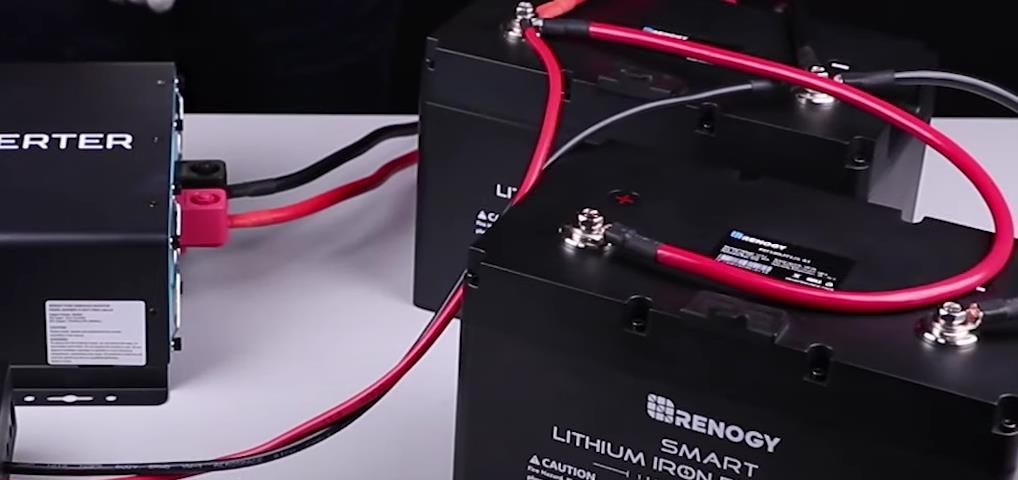
But the life cycle will be increase by parallel connections, as the amp are boosted so that the charge and discharge cycles a battery can release also increase.
Does series or parallel give more power?
Connecting batteries in series or in parallel do not necessarily provide more power rather, they have an effect on the battery bank's voltage and current.
Connecting batteries in series increase the voltage, however, connecting batteries in parallel increase the current or ampere hours. The overall power output of the series or parallel combination is determined by both its voltage and ampere hour ratings(capacity).
In some cases, a series-parallel connection of batteries is used to achieve specific voltage and ampere-hour requirements.
It is important to note that batteries have a limited power output, which is determined by their chemistry, size, and other factors. Therefore, it's important to choose the appropriate battery and configuration for your specific application to ensure optimal performance.
When would you use batteries in parallel?
Batteries can be connected in parallel when you need to increase the capacity of the overall battery system.
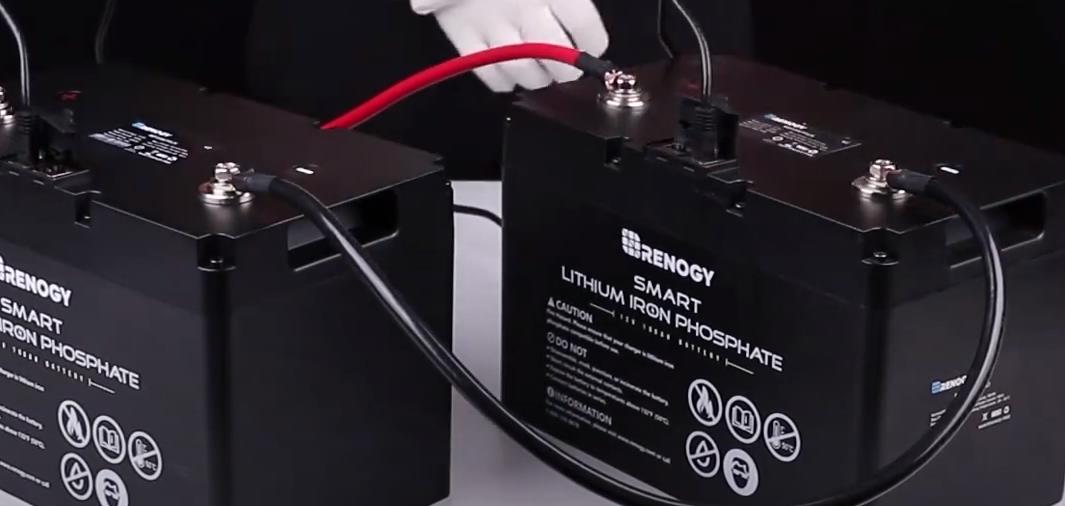
When batteries are connected in parallel, their ampere hours rating are added-up, however the total voltage rating remains same as that of an individual battery. This configuration is commonly used in applications that require high current output for longer periods of time, such as in electric vehicles or solar power systems.
Parallel connections also allow for redundancy, meaning that if one battery fails or loses its charge, the others will continue to provide power. This is especially important in critical applications where a loss of power could result in serious consequences, such as in backup power systems for hospitals or data centers.
What happens when you connect two 12 volts batteries in series?
When two 12-volt batteries are connected in series, the total voltage of the battery system is doubled to 24 volts.
When batteries are connected in series, overall voltage of the battery system is increase, however its capacity remains the same. Series combination of batteries is more applicable and required for many applications that need higher voltage levels. For example, electric vehicles, boats, and RVs that often use battery banks with higher voltages to power their motors.
It is important to note that connecting batteries in series also increases the overall capacity of the battery bank in amp-hours. However, the internal resistance of the batteries can also increase, which can result in a lower maximum discharge rate and reduced efficiency of the battery bank.
What happens if batteries are not properly connected?
The improper connection of batteries can result in a number of issues, including decreased performance and efficiency as well as potentially dangerous situations.
The following are some of the possible outcomes of improper battery connections:
•One or more batteries may discharge more rapidly than the others if they are not connected in a way that ensures a balanced connection, thereby reducing the battery system's capacity as a whole.
•Batteries can overheat as a result of poor connections, which can cause internal damage and shorten the battery's lifespan.
•Incorrect connection of the battery terminals can result in electrical shorts that can harm the batteries, and other equipment, or even start a fire.
•Unfortunate associations can prompt voltage drops and expanded obstruction, lessening the proficiency of the battery system, and making it release all the more rapidly.
•Particularly in applications requiring high current or voltage levels, there is a risk of electric shock, fire, or explosion if the batteries are not connected properly.
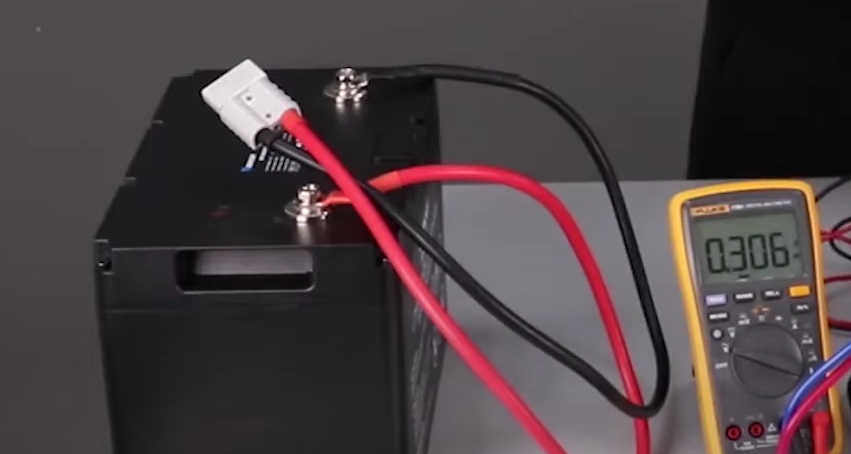
When connecting batteries, it's important to follow the manufacturer's instructions carefully, use the right cables and connectors, and regularly check the battery bank to make sure that all connections are secure and in good condition.
Can you wire different batteries in parallel?
Different types of batteries are not recommended to be wired in parallel, because they have distinct characteristics that can influence the battery bank's overall performance and safety.
For example, lithium batteries discharge up to 100% and lead acid batteries can only discharge like 50%. Connecting them together can result in significant damage to the batteries. In extreme cases, fire or explosion can occur.
What happens when connecting two batteries of different amp hour rating in parallel?
Parallel connecting two batteries of varying amp-hour rating can lead to an uneven distribution of current and voltage between the batteries, because they share different levels of internal resistance. As a result, the larger battery discharges more slowly while a lower capacity discharges faster. In this case, a variety of problem such as a decrease in capacity, a shorter battery life, and potential dangers to safety can happen.
If wiring multiple batteries in parallel is necessary, it is essential to carefully consider each battery's characteristics, make use of the appropriate balancing and monitoring systems, and make certain that the batteries are matched in terms of voltage (discrepancies within ± 0.1 V), capacity, and internal resistance. Moreover, it is generally recommended to use batteries of the same age (age differences limited in three to six months), manufacturer, and type.
Buy the safest lithium batteries for your RV
Renogy has been dedicated to the solar industry for at least ten years, upholding the mission to empower everyone clean energy by presenting them reliable and affordable products.
We have a vast range of product lines including solar panels, charge controllers, inverters, charge controllers, and batteries, and many other components. As solar batteries play a key role in storing solar energy and can be the biggest safety factor in a complete solar system, Renogy has paid much efforts to this, developing reliable batteries, and at the same time, lending them unique features in the industry, such as Bluetooth and self-heating functions.
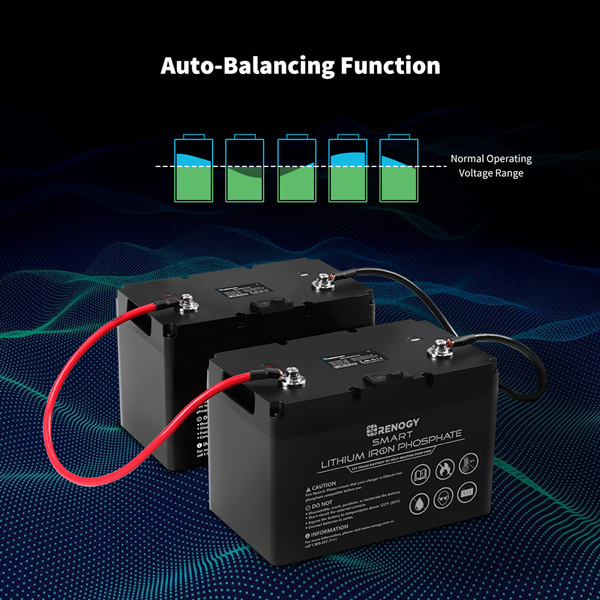
Invest one as your safe battery storage solutions below:
12V 100Ah Smart Lithium-Iron Phosphate Battery
12V 100Ah Smart Lithium Iron Phosphate Battery W/ Self-Heating Function
12V 100Ah Lithium Iron Phosphate Battery w/ Bluetooth
If you need more options, please visit Renogy online store.
Related articles:
How To Charge A Deep Cycle Battery
What is the Best Solar Battery for Solar Storage in Canada?
How many kWh does the average home use?
Solar Panel Maintenance Guide: Practices, Cost, And Frequency







